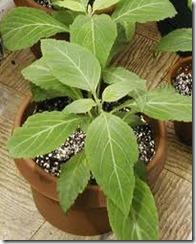-
Salvia (Salvia sivinorum) is a plant of the mint family. It is unique in that it has hallucinogenic qualities similar to those of some mushrooms and has even been compared to LSD. As of June 2010, it is not illegal to grow, consume or sell in many parts of the United States. Keep in mind that in the states of Delaware, Louisiana, Missouri, New Jersey, New York, Tennessee, among others, salvia is legally a controlled substance. Salvanorin A is the compound that decides how strong the salvia’s effect will be but there has been little study into the differences in potency of the strains of the salvia plant.
Wasson and Hoffman strain
-
Wasson and Hoffman was one of the first strains collected in 1962 by ecologist Sterling Bunnell and mis-attributed to Wasson-Hoffman. This is one of the most common strains of clone and the most readily available. The Blosser palatable clone is said to be almost identical to Hoffman-Wasson except for a slightly less bitter taste, thus "palatable." Wasson and Hoffman was the original strain first taken from Mexico and the name "Wasson and Hofmann" was first applied to the strain in 1992. Wasson-Hoffman is considered the most consistently potent strain of Salvia divinorum although there have been few scientific studies of the potency of Salvinorum A, the hallucinogenic compound.
Appalossa
-
Appalossa is known as "the lost clone." Discovered in 1999, it originated as a sport or mutation cutting from an otherwise normal Wasson and Hofmann clone. While the cause has not been explained, it is possible that Appalossa was a chimera, an individual containing genetically different tissues resulting from a somatic mutation. It was very distinctive from most strains of salvia, which look almost identical with leaves marked with patchy white or pale-green areas and white striping on the stems. Appalossa myth has it that its discoverer "The Sage Student" initially thought it was a diseased plant and threw it away. He only later realized that it was a new strain and rescued it from the patch of poison ivy where he had thrown it.
Luna
-
Salvia divinorum is an interesting plant that almost never produces viable seeds. New plants are grown from cuttings and are essentially clones, so when a viable seed grows into an actual plant it becomes a unique strain. Luna was found in Hawaii in a patch of Hofmann and Wasson of Salvia divinorum clones. It is the only clone strain besides Appalossa to have a distinctive "look." It has round, moon-shaped leaves with serrated edges. It was found by Daniel Seibert in 1994. Luna is most likely grown from a seed and is genetically unique.


Deprecated: strpos(): Passing null to parameter #1 ($haystack) of type string is deprecated in /home/agriviek8Qv/agriviet.net/public_html/wp-includes/comment-template.php on line 2522